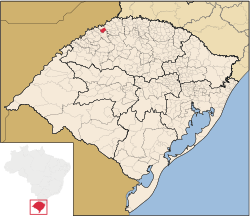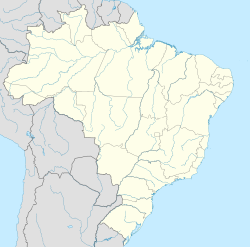Hunsrik, also called Riograndese Hunsrik, Riograndenser Hunsrückisch or Katharinensisch, is a Moselle Franconian language derived primarily from the Hunsrückisch dialect of West Central German which is spoken in parts of South America. A co-official language in the Brazilian municipalities of Antônio Carlos, Santa Maria do Herval, and São João do Oeste, Hunsrik is spoken in the states of Rio Grande do Sul, Santa Catarina, and Paraná, as well as some regions of neighboring Paraguay and Argentina. It has been an integral part of the historical and cultural heritage of the Brazilian state of Rio Grande do Sul since 2012, and considered an intangible cultural heritage of Santa Catarina state since 2016.
Talian, or Brazilian Venetian, or Vêneto is a Venetian dialect spoken primarily in the Serra Gaúcha region in the northeast of the state of Rio Grande do Sul in Brazil. It is also spoken in other parts of Rio Grande do Sul, as well as in parts of Espírito Santo and of Santa Catarina.

São Leopoldo is a Brazilian industrial city located in the south state of Rio Grande do Sul.
The German-based varieties spoken by German Brazilians together form a significant minority language in Brazil. "Brazilian German" is strongly influenced by Portuguese and to a lesser extent by Italian dialects as well as indigenous languages. High German and Low Saxon/German dialects and Germanic languages are particularly strong in Brazil's South and Southeast Regions. According to Ethnologue, ca. 3 million people in Brazil speak the Hunsrik Language, 1.5 million speak Standard German.

Santa Rosa is a municipality in the Brazilian state of Rio Grande do Sul, located at latitude 27º52'15" and longitude 54º28'53" at a height of 277 meters above sea level. It has an area of 488.42 km2. Its estimated population is 73,575 (2020). It is known as the "National Cradle of Soybeans".
Cerro Largo is a municipality in the northwestern part of the Brazilian state of Rio Grande do Sul. It occupies an area of 174.64 km2 (67.43 sq mi) at 28º09'0" south 54º45'0" west, at an elevation of 211 m (692 ft) above sea level. Its population as of 2020 was 14,189 inhabitants.
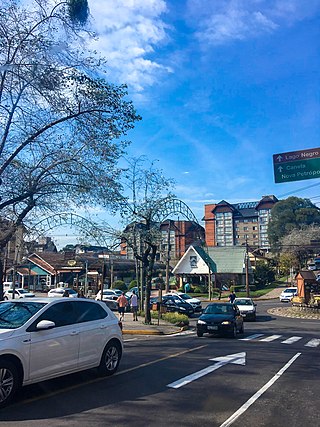
The Serra Gaúcha is a cultural region comprising the mountainous areas in the northeastern portion of Rio Grande do Sul state in southern Brazil. Most of its inhabitants are of German and Italian ancestry. Consequently, the cities in the Serra Gaúcha reflect German and Italian influences through their architecture, gastronomy, and culture. Geographically, it is part of the Serra Geral mountain range.

Portuguese is the official and national language of Brazil being widely spoken by most of the population. Brazil is the most populous Portuguese-speaking country in the world, with its lands comprising the majority of Portugal's former colonial holdings in the Americas.
Missões, Brazil is a region of Rio Grande do Sul in Brazil roughly occupying the same area previously dominated by the colonial missions founded by Saint Roque González.

Campina das Missões is a Brazilian municipality of the state of the Rio Grande do Sul, located at latitude 27º59'20" S and longitude 54º50'22" W, being at an altitude of 163 meters. Its population estimate in 2020 was 5,398 inhabitants.

Pirapó is a municipality of the western part of the state of Rio Grande do Sul, Brazil. The population is 2,254 in an area of 295.01 km2. The town is situated by the Ijuí River, close to its confluence with the Uruguay River, which forms the border with Argentina. It is located 563 km west of the state capital of Porto Alegre and northeast of Alegrete.
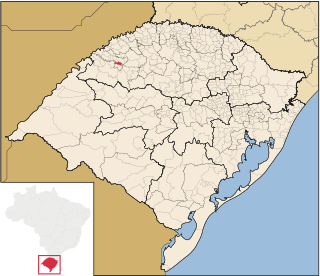
Mato Queimado is a Brazilian municipality located in the northwestern part of the state of the Rio Grande do Sul. The population is about 1,629 in an area of 114.64 km². It is located 489 km in the west of the state capital of Porto Alegre and northeast of Alegrete.

Três de Maio is a Brazilian municipality in the state of Rio Grande do Sul. It is located at 27.752602°S 54.243707°W.

Picada Café or Kaffeeschneiss in the local German dialect is a municipality in the state of Rio Grande do Sul, Brazil. It is located around 80 kilometers from the state capital of Porto Alegre.

Salvador das Missões is a municipality in the state of Rio Grande do Sul, Brazil. As of 2020, the estimated population was 2,733.
São Paulo das Missões is a municipality in the state of Rio Grande do Sul, Brazil. As of 2020, the estimated population was 5,720.

São Pedro do Butiá is a municipality in the state of Rio Grande do Sul, Brazil. As of 2020, the estimated population was 2,949.

Itapiranga is the westernmost municipality in the Brazilian state of Santa Catarina.
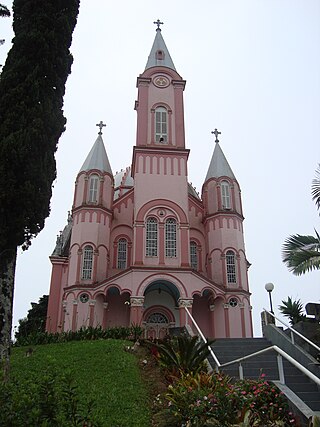
São Pedro de Alcântara, Santa Catarina is a municipality in the state of Santa Catarina in the South region of Brazil.

São João do Oeste is a municipality in the state of Santa Catarina in the South region of Brazil.
